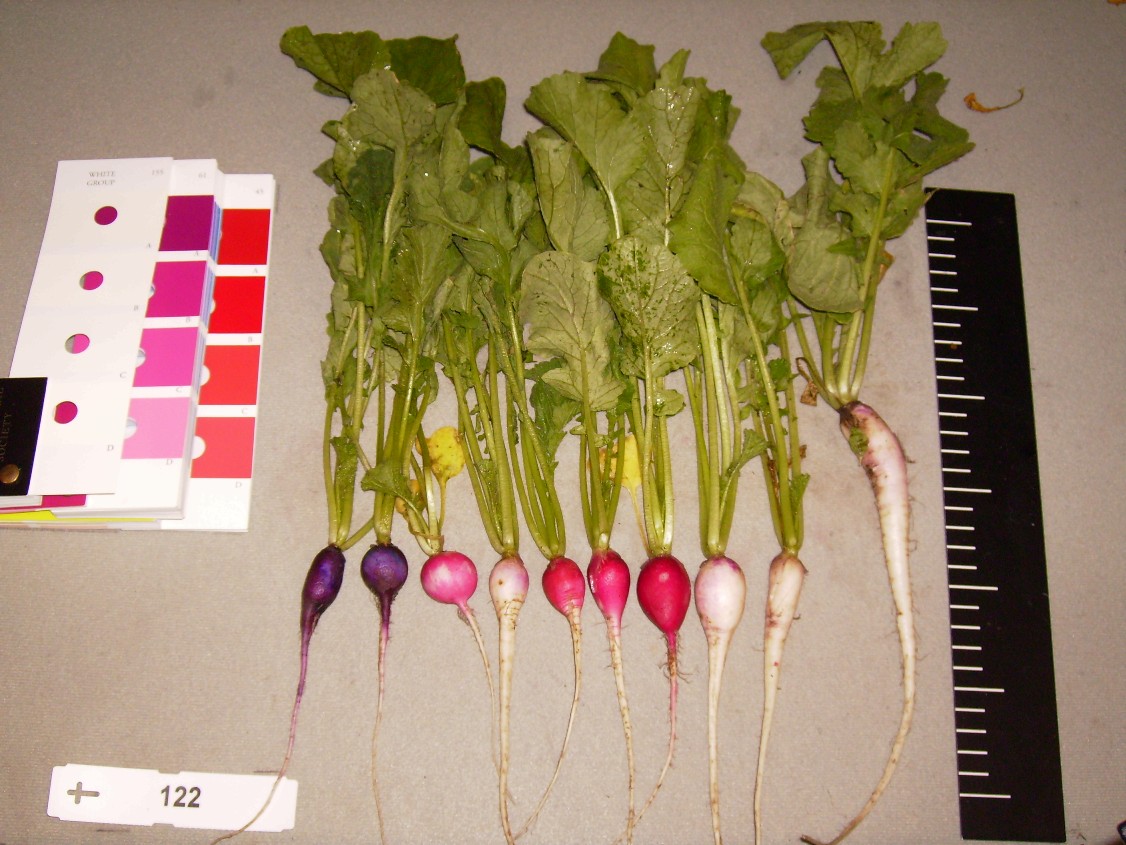Characterization of radish genetic resources
Contributors to this page: CAAS, China (Qiu Yang, Li Xixiang); Bioversity International, Italy (Imke Thormann, Ehsan Dulloo); CGN, Netherlands (Noortje Bas); IPK, Germany (Andreas Börner, Ulrike Lohwasser); AVRDC, Taiwan (Andreas Ebert); USDA, USA (Larry Robertson); NBPGR, India (Chitra Pandey); SASA, UK (George Campbell); University of Warwick, UK (Charlotte Allender).
|
Contents: |
Environment
- Choose a field in which the previous crop was not a crop belonging to the Brassicaceae family.
- Light soils are preferable e.g. sandy loam, silt loam, or soils with high organic matter with good drainage and deep soils with a pH of 6.0-7.0 and uniform fertility.
- Surrounding climate (temperature, light, etc.) should meet the requirement of radish plant growth and development.
Season
For vegetative growth
- Radish is a cool-weather, short-season vegetable crop. It grows best in cool and moist weather (15-22°C for leaf, 13-18°C for root).
- It is grown during spring and autumn in temperate zone and during the cooler parts of the year in the tropics.
For reproductive growth
- Radish flowers (bolt) initiate after vernalization. It is important to expose plants to cool outside temperatures below 15°C for at least 20 days.
- Another option is to store the germinating seeds or radish seedlings with two leaves in a cool room at 2-5°C for 14 to 40 days. A few accessions need 2-5℃ for more than 60 days.
- Temperature at flowering and seed set is optimal at 25± 3 °C. Radish may be sown at the end of winter (January) in a non-heated greenhouse and planted in the field in spring (mid-March In North China).
Plot size
- Row to row distance 30-60 cm – 90 cm are used in AVRDC, 3-45 cm between plants depending on the radish type and the vegetative or reproductive growth.
- Plant border rows around the plot.
Replications
- No replications are needed.
Standard check cultivars
- Use standard varieties for all characterizations.
Descriptors for characterization
|
|
Morphological descriptors for characterization
- See list for radish descriptors developed by IBPGR, (now Bioversity International, 1990), CAAS descriptors, or UPOV (such as the ‘UPOV Guidelines for the Conduct of Tests for Distinctness, Uniformity and Stability’ for Black Radish (TG/63/6), Fodder Radish (TG/178/3) and Radish (TG/64/6), used by SASA).
Pictures for characterization
Sufficient detail should be captured in images to taxonomically identify the plant and demonstrate the traits that show variation.
- Take images for character(s) which may be difficult to describe verbally or to score.
- Images of whole plant, racemes (if applicable), flowers, siliques.
- Store pictures in a database file linked to other characterization data.
Molecular markers for characterization
- SSR, EST-SSR, AFLP, RAPD (more efficient techniques).
Recording information during characterization
The following information should be recorded for each trial:
- Observation location
- Culture season and condition
- Sowing and planting date.
- Bolting date
- Fleshy root harvest date
- Bolting date
- Data collector (full name).
- Date of data collection (this may be done several times, record the date of each time for specific character in remarks)
- All data of morphological or molecular characterization for each accession
System for characterization data
- All basic information, morphological data and pictures should be stored in one of the modules of the genebank documentation system.
References and further reading
Beattie JH. 1882. Production of radishes. [online]. Washington, D.C.. UNT Digital Library. Available from: http://digital.library.unt.edu/ark:/67531/metadc1562/m1/1/. Date accessed June 8, 2010.
Cornell University. 2006. Growing guide: Radishes. [online] Cornell University. Available from http://www.gardening.cornell.edu/homegardening/scene341b.html. Date accessed June 8, 2010.
Dainello FJ. 2003. Radish. Texas Cooperative Extension, Horticulture Crop Guides Series. Available from http://aggie-horticulture.tamu.edu/extension/vegetable/cropguides/radish.html. Date accessed June 8, 2010.
IBPGR. 1990. Descriptors for Brassica and Raphanus. International Board for Plant Genetic Resources, Rome, Italy. Published in association with the Commission of the European Communities. Available here (1.5 MB).
Li XX, Shen D, Wang HP, Song JP et al. 2008. Descriptors and Data Standard for Radish (Raphanus sativus L.). Beijing: Chinese Agricultural Press.
Radish. [online] New world Encyclopedia. Available from http://www.newworldencyclopedia.org/entry/Radish. Date accessed June 8, 2010.
Shippers RR. 2004. Raphanus sativus L. [online] Record from Protabase. Grubben GJH, Denton OA, editors. PROTA (Plant Resources of Tropical Africa / Ressources végétales de l’Afrique tropicale), Wageningen, Netherlands. Available from: http://database.prota.org/search.htm. Date accessed: 22 January 2010.
Comments
- No comments found



 Characterization
Characterization

Leave your comments
Post comment as a guest